1000U to open 10x, holding value 10000U; 2000U to open 5x, holding value 10000U; the value is the same, but the liquidation price is different, so don't focus on the liquidation price when trading; the important thing is to set stop-loss.
True cryptocurrency trading experts simplify things; they repeat simple tasks. This short-term trading model has a win rate as high as 98.8%. Learning it can help you easily turn 100,000 into 10 million, focusing solely on this one model.
I met a friend from Fujian who likes to do short-term trading, especially enthusiastic about many techniques. In just a few years, he expanded from small to large and now makes a living by trading cryptocurrencies. After improving his 'techniques' and practicing this year, he has turned an initial capital of 170,000 into 40 million in less than a year. I hope this can help everyone!
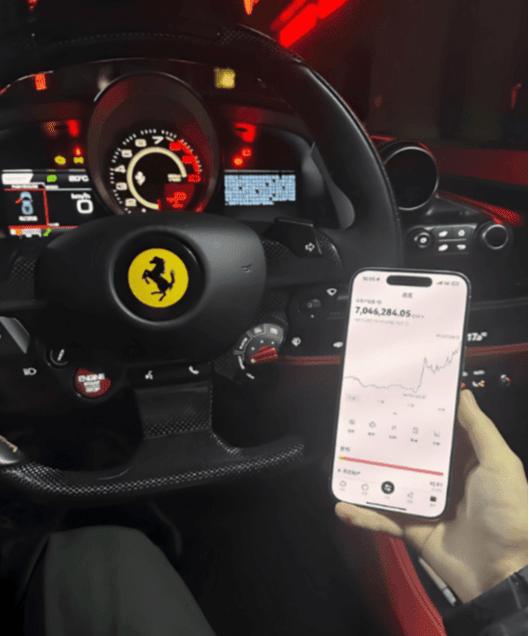
I have been trading cryptocurrencies for 10 years, earning 60 million. If you want to change your fate, you must try the cryptocurrency circle; if you can't get rich in this circle, an ordinary person will have no chance in their lifetime.
Cryptocurrency trading methods:
1. Buy mainstream value coins in large positions, spot (do not trade contracts), regardless of whether they rise or fall, hold them for the medium to long term based on the entry price, and use rolling position strategies (adding or reducing positions)
When the market experiences a sharp decline, do not panic if the four-hour chart does not break the 20-day line; there are several reasons:
a. Explosive contracts: Without absolute confidence, do not easily play contracts; they are completely different from spot data. Preserve your capital to continue enjoying the dividends of the bull market!
b. Demand for pullbacks: After a surge in mainstream value coins, when there is a gap up in the 5-day line, it generally must pull back to the 5-day line, or even the 10-day line, before continuing to rise!
C. Retail investors: Retail novices like to chase highs and sell lows; after retail investors chase high prices, the market makers quickly drop, scaring retail investors into cutting losses and handing over their positions.
2. For profitable swing trades, reduce positions in advance, or sell in batches at high levels to lock in profits;
3: Pre-set buy orders in batches at the 5-day, 10-day, and 30-day moving averages on the daily chart to accumulate at low levels.
4: Based on the life line trading method + judging the trend of rising and falling prices, if the trend changes significantly, break below, pull back to the life line and reduce positions in a timely manner.
5. During a bullish surge, be sure to have risk awareness; do not blindly chase highs. During a bearish drop, have opportunity awareness and accumulate positions in batches at low levels.
6: Reduce positions moderately on profitable chips to avoid rollercoaster trading; for bottom-buying orders, it is recommended to set stop-loss to protect capital.
7: If the direction is unclear, it's better to miss it than to make a mistake. Preserve your capital, and you can smile longer.
Without further ado!
I will share my trading strategies and insights with friends. There’s a saying: standing on the shoulders of giants can save ten years of hard work. If you are fortunate to see this,
Friends who want to improve their cryptocurrency trading skills must read more and study carefully.
Viewing the market with a developmental perspective is a state of infinity.
How should this sentence be understood?
In simple terms, it means whenever you have time, open your computer and check if you can make a trade to earn some money.
Previously, I introduced intraday short-term trading, which has strategies and techniques that many short-term enthusiasts appreciate; however, some friends feel that intraday short-term trading requires frequent chart monitoring, which is too tiring and stressful.
They want to hold a trading position for a long time but do not want to constantly check the charts; they hope to set larger profit targets while keeping losses limited. So, is there such a trading method?
The answer is yes, that is swing trading.
Swing trading is a very popular type of trading that has relatively low stress for traders but offers very considerable returns, especially for part-time traders; it is the most perfect trading type.
But before introducing swing trading, I need to emphasize one thing:
Regardless of trading style, traders in the market are fighting alone, responsible for their account funds; even in loss, they cannot blame others. It cannot be said which is better; it only depends on which method you prefer and which suits you better.
Take today's forex swing trading expert as an example; he has been in the industry for over ten years, tried various trading types and strategies, yet still frequently faced liquidation.
Until he discovered through swing trading that for him, swing trading is the best type of trading, and the daily chart can provide him with the most accurate trading signals.
Therefore, to achieve stable profits in forex trading, the first step is to find a trading style that suits you, then refine your trading strategy, rather than blindly imitating others.
01 The advantages and disadvantages of short-term and swing trading
Since you need to find a trading style that suits you, you must first understand the pros and cons of each style. Let's first look at the advantages and disadvantages of short-term trading and swing trading:
The advantages and disadvantages of short-term trading are as follows:
The opportunities for short-term fluctuations in the market are abundant, with trading opportunities at 1-minute, 5-minute, and 15-minute intervals.
The intraday trading model effectively locks in short-term trading goals, making trading have clear pursuits and evaluation indicators.
Intraday trading can lock in risks. Forcing intraday stop-loss based on funds and points, distributing funds for operational ratios, quantifying positions, and implementing risk control more effectively.
Disadvantages:
Frequent trading carries a higher risk probability.
Long periods of monitoring consume energy, causing significant pressure and being detrimental to health.
The advantages and disadvantages of swing trading
Advantages:
. Will choose trades with higher profit possibilities;
. Less pressure than intraday trading; does not require you to focus on charts all day long; trading costs are lower than intraday trading.
Disadvantages:
. Long holding periods bring overnight risks;
, need more patience, need stronger principles.
Intraday trading has more potential profits, while swing trading offers more freedom and less pressure. In terms of whether one can be profitable, any trading method can yield profits, but the focus is still on personal character, skills, and knowledge.
Next, I will share this swing trading expert's understanding of swing trading and detail the six steps he takes in swing trading.
02 What is swing trading?
Short-term trading was introduced in last week's article, so I won't repeat it today. Friends who haven't seen it can check it out in the 'You Might Have Missed' section at the end of the article. Today, we will mainly learn about swing trading.
Swing trading (also known as swing trading) is a trading strategy that attempts to capture a significant wave of rising or falling prices, with holding periods ranging from a few days to a few weeks.
Swing traders looking for trading opportunities through technical analysis will also use fundamental analysis to analyze price trends and patterns.
Swing trading mainly consists of two parts—swing and fluctuation points. As shown in the figure below:
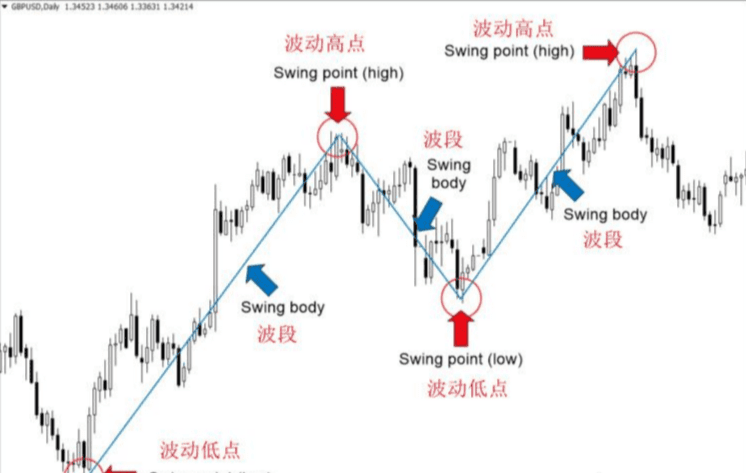
03 How to perform swing trading?
Next, I will introduce the six steps of swing trading.
1 Pay attention to the daily chart
Observe the daily chart more, as it provides the most comprehensive price trends and more reliable price signals.
However, it should be noted: not all daily charts are worth paying attention to.
I mainly use the daily chart with New York closing prices. Because every 24 hours, the trading session closes at 5 PM Eastern Standard Time in the United States, which is referred to as the 'market closing time' in the forex market.
Therefore, I recommend that swing traders best use daily charts. If you have already profited using daily charts, then you can try using 4-hour charts.
In summary, generally speaking, a higher time frame signifies more reliable price action signals.
2 Draw key support and resistance levels
Draw key support and resistance levels; this is the most important part of the entire process. For swing traders, if key support and resistance levels are not found, profits will not be possible.
Next, I will introduce two important horizontal lines:
1. Support and resistance lines
Support and resistance are points on the chart that withstand continuous upward or downward pressure. Support levels are usually the lowest points in all chart patterns, while resistance is the highest point (peak) in the chart.
Additionally, support and resistance levels are usually not 'exact' levels; it is best to view them as a range.
2. Trend lines
Although trend lines are one of the most common methods in technical analysis, not all traders will use them, possibly because most traders cannot draw correct trend lines.
Generally speaking, an uptrend line connects the lows of each fluctuation, while a downtrend line connects the highs of each fluctuation.
3 Judging oscillations
If you can already mark support and resistance zones on the daily chart, the next step is to use the fluctuation highs and lows to determine the oscillation.
There are mainly three types of oscillations: uptrend, downtrend, and range trend.
1. Uptrend
Higher highs and higher lows; the chart below shows a typical uptrend:
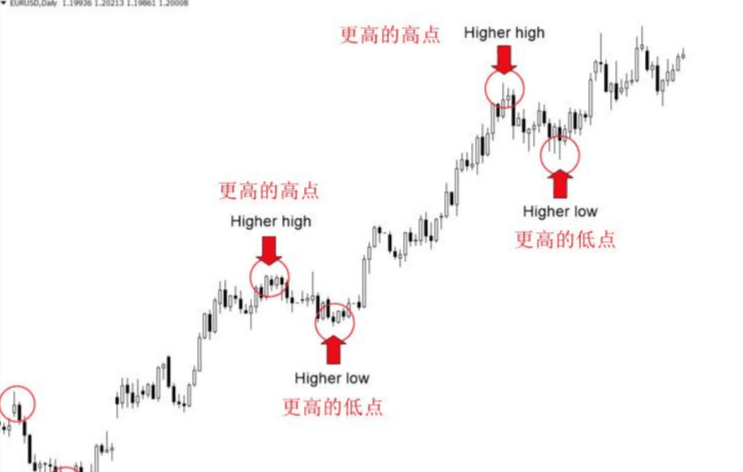
In the chart above, each peak is higher than the previous one, and in this bullish trend, you can buy.
2. Downtrend
Lower highs and lower lows; the chart below shows a typical downtrend:
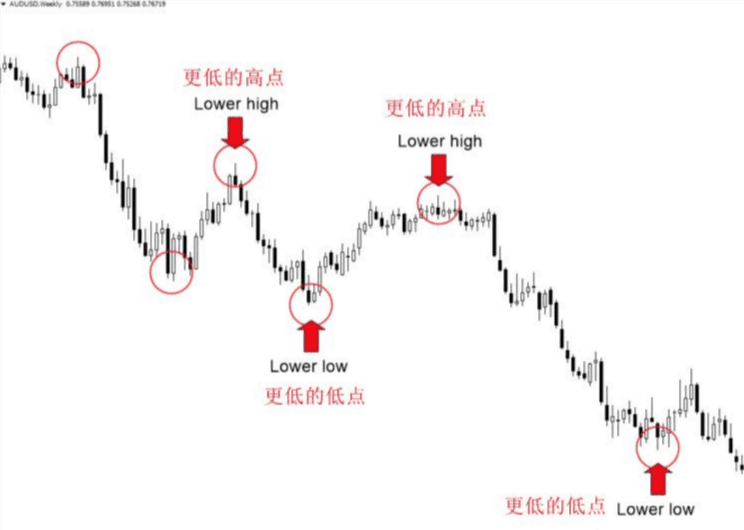
In the chart above, each peak is lower than the previous one, at this point you can sell.
3. Range trend
Horizontal movement, also known as a consolidation period, as shown in the figure below:
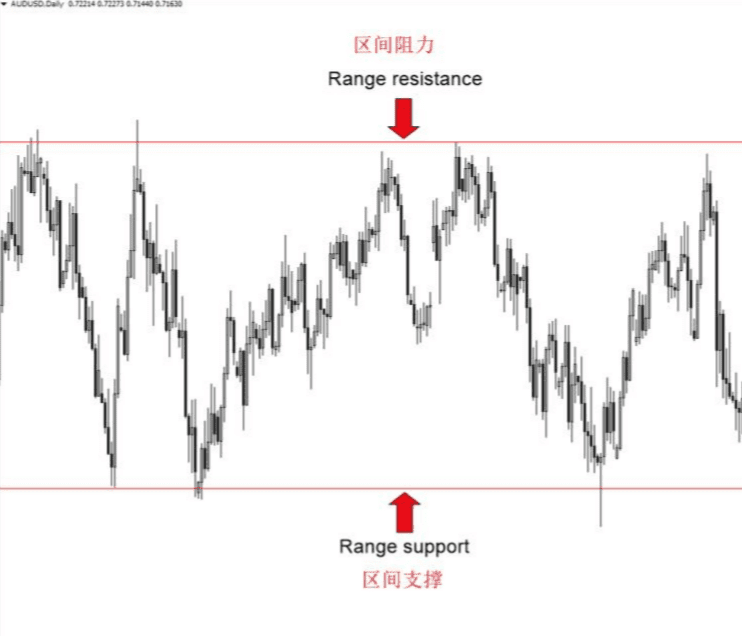
Range trends are the most common type of trend. Although the chart above does not show a bullish or bearish trend, swing traders can still profit within this range, and it may even be easier to profit than in the other two oscillating trends.
What to do?
Utilize support and resistance levels. As shown in the figure below, pay attention to the two pin bars in the chart:
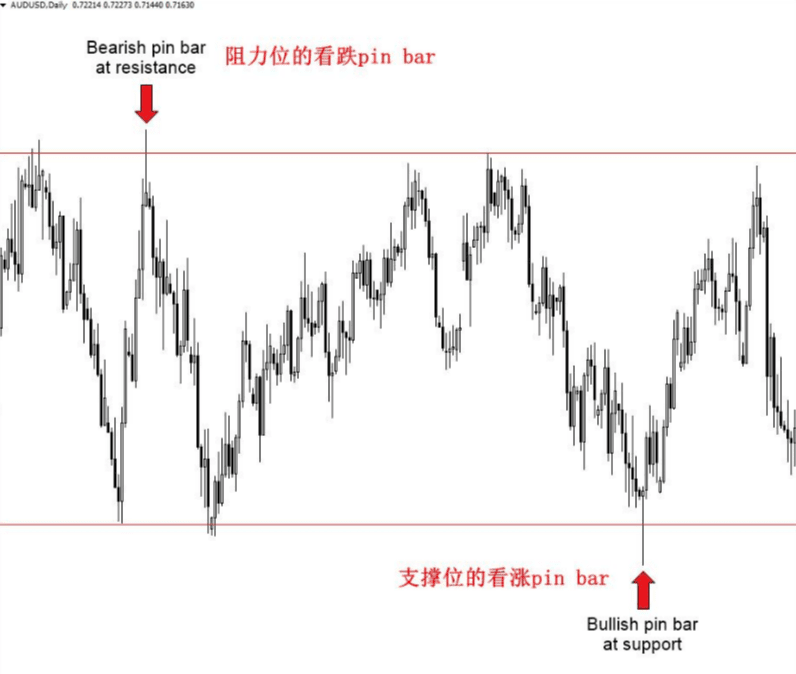
4 Look for price action signals
Through the above three steps, you have identified the oscillation currently on the daily chart.
1. If the market is in an uptrend, then you should start to pay attention to buying signals at key support levels, as shown in the figure below, where a bullish pin bar has appeared at the key support level.
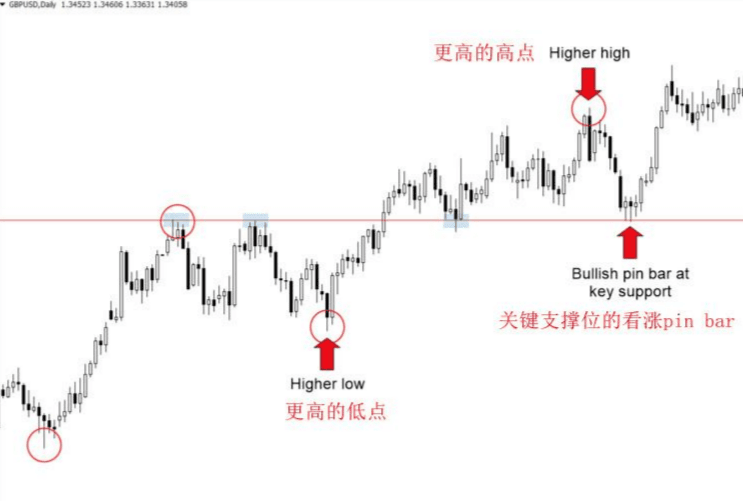
The bullish pin bar in the above chart is a buy signal, meaning we can profit in the ongoing upward trend of the market.
2. If the market is in a downtrend, then you should pay attention to selling signals at resistance levels, as shown in the figure below:
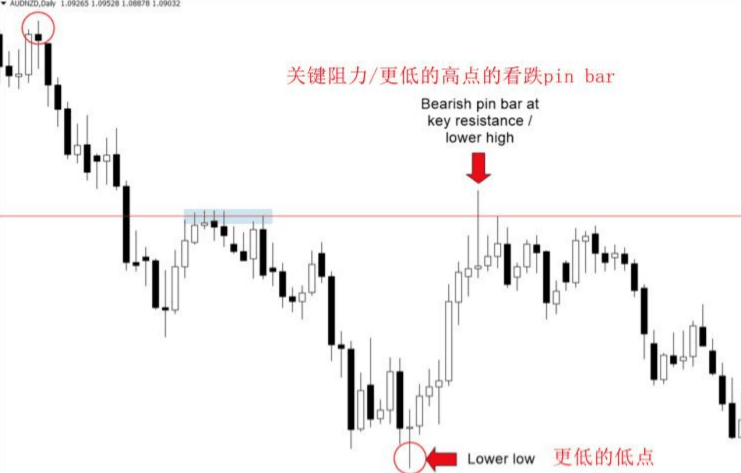
We can use the bearish pin bar in the chart as a sell signal.
In fact, for swing traders, catching the entire swing is difficult. What we can do is focus as much as possible on the changes in swings and patiently wait until the price trend is confirmed before entering a trade.
5 Determine the exit point
Determining the exit point has an important prerequisite: to determine the take-profit and stop-loss before entering. This is because once you enter, your emotions will be affected by market changes.
So, how do you determine the exit point?
It's simple, still relying on support and resistance levels, as shown in the figure below:
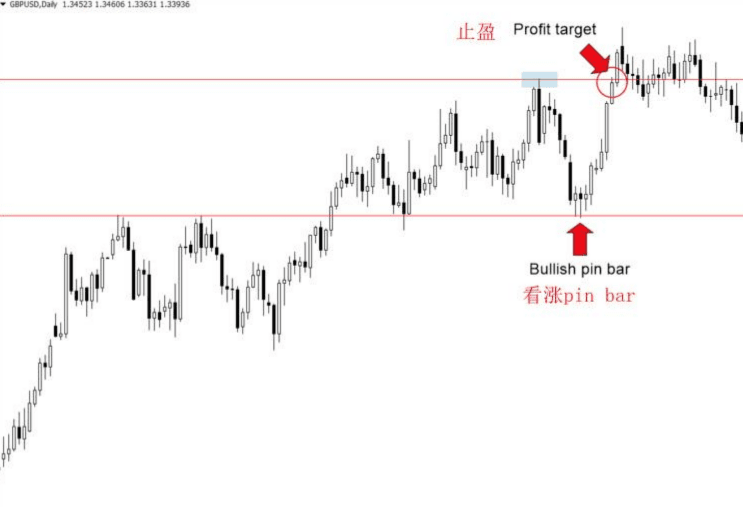
The chart above is a GBPUSD daily chart: it is clearly an uptrend, and the price has exceeded our set profit target.
When this happens, there is no need to be frustrated; we have captured most of the upward trend. Remember, when trading, do not be too greedy.
Let's take a look at the AUDNZD daily chart: We can also determine take-profit based on support and resistance levels, which is the exit point. As shown in the figure below:
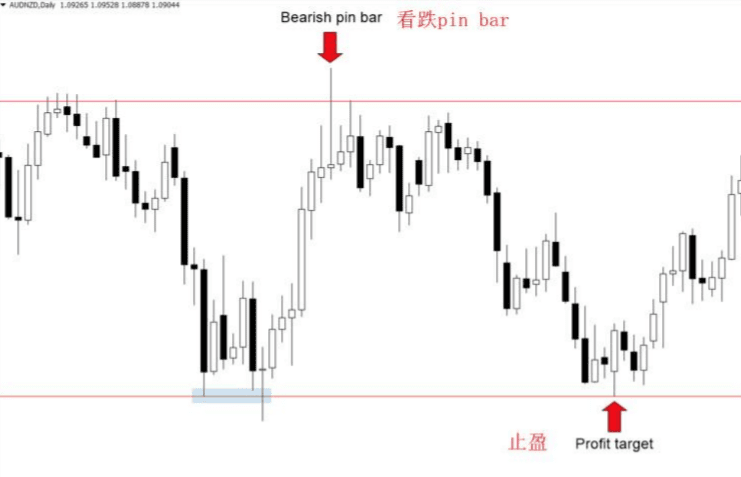
In summary, support and resistance zones and trend lines are the foundation of all trading setups. Once these are determined, entry and exit points become clear.
6 Calculate and manage risk
Currently, risks are usually calculated using R multiples. For example, setting a 100-point stop-loss and a 300-point take-profit is 3R. If your capital is 100 dollars and you earn 500 dollars, the risk-reward ratio is 5R.
Risk management essentially means stop-loss and take-profit:
Stop-loss: The best stop-loss level is either at the upper or lower end of the pin bar.
If a bullish or bearish engulfing pattern appears, it is best to set the stop-loss level 10 to 20 points above or below the candlestick.
Take-profit: Take-profit is still related to key support and resistance levels. For swing traders, the key to profit is capturing the fluctuations between support and resistance levels.
If an uptrend appears in the market and a bullish pin bar forms at the support level, the take-profit should be set at the next key resistance level.
Still, the same saying: If you don’t know what to do in a bull market, click on the profile of the old blogger, follow them, and get strategies for spot trading and contract passwords, shared for free.

